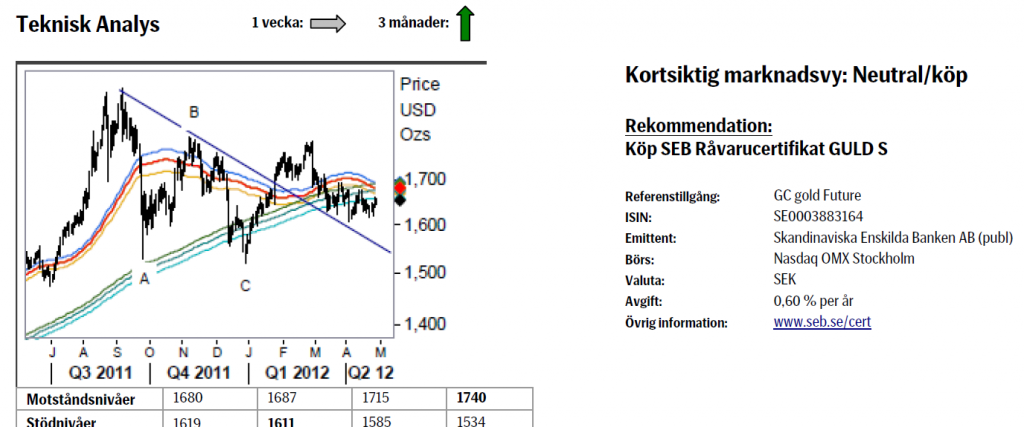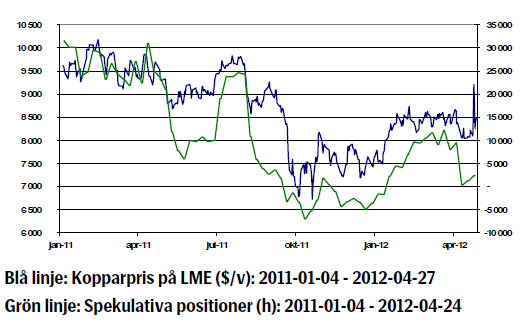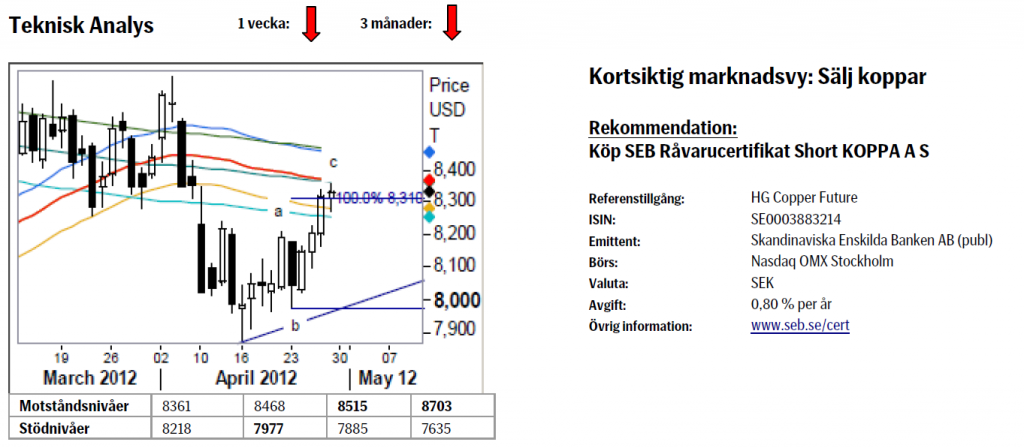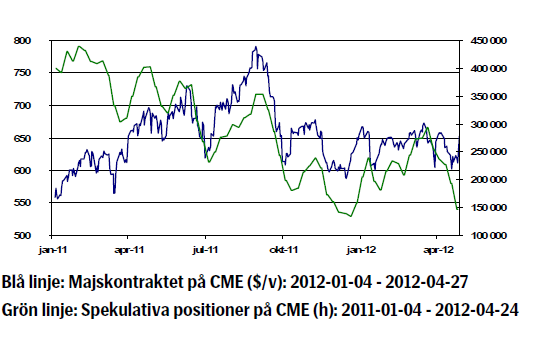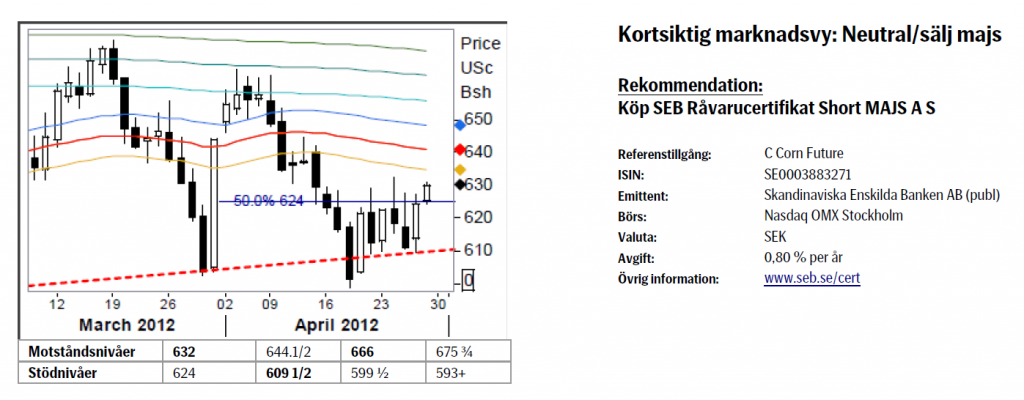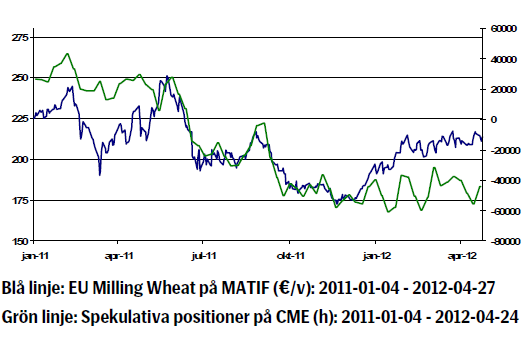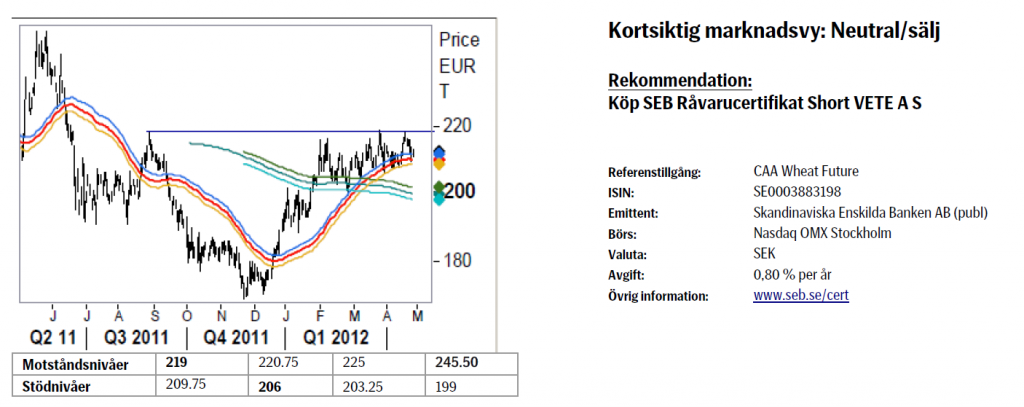Analys
SEB – Råvarukommentarer vecka 18 2012
Sammanfattning: Föregående vecka
 Brett råvaruindex: +1,62 %
Brett råvaruindex: +1,62 %
UBS Bloomberg CMCI TR Index- Energi: +1,42 %
UBS Bloomberg CMCI Energy TR Index - Ädelmetaller: +2,12 %
UBS Bloomberg CMCI Precious Metals TR Index - Industrimetaller: +3,47 %
UBS Bloomberg CMCI Industrial Metals TR Index - Jordbruk: +0,59 %
UBS Bloomberg CMCI Agriculture TR Index
Kortsiktig marknadsvy:
- Guld: Neutral/köp
- Olja: Sälj
- Koppar: Sälj
- Majs: Sälj
- Vete: Neutral/sälj
Guld
- Guldet steg 1,97 procent förra veckan och har för tillfället svårt att bryta ut på uppsidan. Flera länder går till val i Europa vilket försvårar för gemensamma förhandlingar. Tidigare överenskommelser såsom den förhandlade budgetpakten, som drivits fram av Tyskland, kan komma att rivas upp eller omförhandlas vilket försvagar euron och ger styrka till dollarn vilket i sin tur dämpar guldpriset.
- I USA redovisade U.S Mint guldmyntförsäljningen för april vilken var den lägsta på fem år. Endast 17 000 troy ounce (ett troy ounce är ca 31 gram) har sålts i april jämfört med 70 000 ton under årets tre första månader. Spekulativa positioner på Comex har också minskat.
- Fed lämnade räntan oförändrad vilket ger stöd åt guldpriset samtidigt som avsaknaden av ytterligare stimulanser verkade dämpande. Guldpriset var oför-ändrat på Feds räntebesked.
- Centralbanker är fortfarande nettoköpare av guld och den ryska centralbanken ökade sin reserv med 15,5 ton. Guldet kommer troligen från inhemsk produktion. Börsen i Shanghai kommer att införa högre marginalkrav för några råvaror, däribland guld. Höjningen träder i kraft den 27:e april. Detta kan tillfälligt förhindra prisökningar.
- Teknisk Analys: Dubbelbotten? Bara marginella rörelser noterade sedan förra fredagen. Dock har vi fått ett par spikar på nedsidan vilket visar att köparna har visat intresse under 1640 området något som vi tolkar lätt positivt. Som tidigare krävs dock åtminstone en uppgång över 1680 för att öka på sannolikheten för att en botten äntligen är på plats.
Olja
- Europa fortsätter att oroa marknaden och statistik från det viktiga dragloket Tyskland har varit sämre än förväntat. Preliminära inköpschefsindexet för den tyska industrin sjönk till 46,3 i april jämfört med 48,4 i mars. Det är den lägsta siffran på 33 månader. Att S & P:s beslutade att sänka Spaniens kreditbetyg två steg med fortsatt negativa utsikter spär på oro och ovisshet.
- Fed lämnade räntan oförändrad på onsdagen med en förväntad låg ränta t.o.m. slutet av 2014 eftersom de ekonomiska förhållandena enligt Fed kräver en extrem lågräntepolitik. Vad gäller kvantitativa lättnader så är Fed redo att göra mer om förhållanden i marknaden skulle kräva det. Oljepriset steg på beskedet att Fed trots allt reviderade upp sin prognos för amerikansk tillväxt i 2012.
- Förra veckan gjorde Iran ett utspel där landet meddelade att man kommer att överväga Rysslands förslag om att inte vidareutveckla landets kärnvapenprogram och att tillåta ytterligare inspektioner. Utspelet kan mycket väl vara ett sätt för landet att vinna tid. Oljan sjönk en procent efter uttalandet. Nytt atommöte med Iran kommer att hållas i Bagdad den 23:e maj.
- Veckostatistik från American Petroleum Institute (API) visade att råoljelager föll med en miljon fat medan onsdagens DOE siffra visade att råoljelager steg med fyra miljoner fat mot förväntade tre miljoner.
- Teknisk Analys: Återtest av bandet & sedan ned. Vi bör nu vara i slutfasen av återtestet av 55 dagars bandet (vi flaggade för förra veckan). Återtestet har gått långsammare än förväntat vilket å andra sidan visar på lågt deltagande av köpare, något som passar bra in i vår nu något mer negativ vy.
Koppar
- S & P:s beslutade i torsdags att sänka Spaniens kreditbetyg två steg med fort-satt negativa utsikter. Motiveringen är en ökad risk att spanska staten behöver mer kapital för att kunna bistå bankerna samt risk för två år med recession. Hela Eurozonen fick en känga av S & P: ”strategin att hantera Europas stats-skuldkris fortsätter att sakna effektivitet.” Euroländerna måste besluta om man ska hjälpa Spanien.
- Dollarn stärktes på S & Ps besked och kopparpriset steg t.o.m något trots dollarns förstärkning.
- Enligt kinesiska myndigheter importerade Kina 345,7 ton koppar i mars vilket är en minskning med 8 procent från februari. Flera rapporter bekräftar att koppar-lagren i Kina är välfyllda till bredden. Inkluderat 600 000 ton i frihamnslager uppges lagren uppgå till 1 miljon ton. Enligt estimat finns ¾ av globala lager i Kina nu. Marknaden i Kina är stängd idag.
- Terminskurvan i koppar är i backwardation dvs. framtida förväntade priser är billigare än aktuellt pris och denna skillnad blir allt större vilket vi tolkar som att tillgången på koppar utanför Kina är begränsad USA:s BNP ökade med 2,2 procent på årlig basis under det första kvartalet vilket var lägre än vad analytiker hade räknat med enligt Bloomberg. Siffran kan tolkas på så sätt att sannolikheten för kvantitativa lättnader ökar.
- Teknisk Analys: Färdig korrektion. Studsen upp från trend linjen blev lite starkare än vad vi initialt räknade med (8218) vilket i och för sig inte ändrar nå-got av den större vyn. Vi ser fortfarande marknaden som negativ och kommer att fortsätta göra så länge vi inte återetablerar oss över medelvärdesbanden.
Majs
- Majspriset steg ca en halv procent förra veckan. Vi kan se en fortsatt hög volatilitet i majsmarknaden, där majkontraktet i Chicago handlades upp och ned med några procent varje dag, men utan tydlig riktning.
- En faktor som hjälpt till att trycka upp priset är den kinesiska efterfrågan, där USDA i början av veckan kom ut med statistik som påvisade en god export av amerikansk majs till okända destinationer. Det kunde senare under veckan bekräftas att en stor del av denna majs gått till Kina.
- Samtidigt har det spekulerats en hel del kring huruvida den goda starten på den amerikanska majsplanteringen ska kunna fortsätta på samma sätt framöver, där det funnits en viss oro för att det kalla väder som råder norr om flera viktiga majsstater ska leta sig söderut. Då en mängd prognoser visat på att så inte är fallet har oron minskat och med dessa även efterfrågan på majs.
- Vi anser inte att förra veckans uppgång kan motiveras av stark efterfrågan från Kina och tror med detta att majspriset under den kommande veckan kommer att kunna falla tillbaka något.
- Teknisk Analys: Lite förvirrat. Efter det falska brottet under botten linjen samt efterföljande test och studs av densamma ser det ut som om marknaden skulle kunna vara på väg att söka sig norrut. Å andra sidan har vi än så länge inte lyckats hålla oss kvar över mitten punkten, 624, av den kraftigt stigande ”candlen” per 30:e mars. För att minska förvirringen måste vi bryta antingen 632 eller 609 ½.
Vete
- Vetet i Paris föll nära två procent veckan som gick. För närvarande är korrelationen mellan det amerikanska och det europeiska vetet mycket låg.
- I Europa är det en blandad utveckling med förhållandevis goda prognoser avseende veteskörden i Tyskland, Storbritannien och Frankrike. Samtidigt är förutsättningarna bedrövliga i Spanien, där man gång på gång tvingas justera ned sina produktionsestimat.
- I början av veckan kom International Grains Councils senaste spannmålsrapport, i vilken organisationen justerar ned sin prognos för den globala veteskörden. Denna nedrevidering av tidigare estimat är i princip uteslutande baserad på de europeiska köldproblemen från första kvartalet.
- Vi förhåller oss neutrala till svagt negativa till vetet i Paris denna vecka, där vi dock är beredda att snabbt positionera oss mot en nedgång om planteringssiffrorna fortsätter att överraska oss positivt i USA och Europa.
- Teknisk Analys: Tunga motstånd bromsar. Efter att i princip ha tangerat årshögsta faller vi tillbaka något i vad som får anses vara en mindre vinsthemtagning. Vidare behöver nog marknaden samla lite styrka för att kunna ta sig an ett så pass tungt motstånd som 219-området. Det mest troliga utfallet ser ut att bli intervall handel mellan medelvärdesbandet och topp området.
[box]SEB Veckobrev Veckans råvarukommentar är producerat av SEB Merchant Banking och publiceras i samarbete och med tillstånd på Råvarumarknaden.se[/box]
Disclaimer
The information in this document has been compiled by SEB Merchant Banking, a division within Skandinaviska Enskilda Banken AB (publ) (“SEB”).
Opinions contained in this report represent the bank’s present opinion only and are subject to change without notice. All information contained in this report has been compiled in good faith from sources believed to be reliable. However, no representation or warranty, expressed or implied, is made with respect to the completeness or accuracy of its contents and the information is not to be relied upon as authoritative. Anyone considering taking actions based upon the content of this document is urged to base his or her investment decisions upon such investigations as he or she deems necessary. This document is being provided as information only, and no specific actions are being solicited as a result of it; to the extent permitted by law, no liability whatsoever is accepted for any direct or consequential loss arising from use of this document or its contents.
About SEB
SEB is a public company incorporated in Stockholm, Sweden, with limited liability. It is a participant at major Nordic and other European Regulated Markets and Multilateral Trading Facilities (as well as some non-European equivalent markets) for trading in financial instruments, such as markets operated by NASDAQ OMX, NYSE Euronext, London Stock Exchange, Deutsche Börse, Swiss Exchanges, Turquoise and Chi-X. SEB is authorized and regulated by Finansinspektionen in Sweden; it is authorized and subject to limited regulation by the Financial Services Authority for the conduct of designated investment business in the UK, and is subject to the provisions of relevant regulators in all other jurisdictions where SEB conducts operations. SEB Merchant Banking. All rights reserved.
Analys
Tightening fundamentals – bullish inventories from DOE

The latest weekly report from the US DOE showed a substantial drawdown across key petroleum categories, adding more upside potential to the fundamental picture.

Commercial crude inventories (excl. SPR) fell by 5.8 million barrels, bringing total inventories down to 415.1 million barrels. Now sitting 11% below the five-year seasonal norm and placed in the lowest 2015-2022 range (see picture below).
Product inventories also tightened further last week. Gasoline inventories declined by 2.1 million barrels, with reductions seen in both finished gasoline and blending components. Current gasoline levels are about 3% below the five-year average for this time of year.
Among products, the most notable move came in diesel, where inventories dropped by almost 4.1 million barrels, deepening the deficit to around 20% below seasonal norms – continuing to underscore the persistent supply tightness in diesel markets.
The only area of inventory growth was in propane/propylene, which posted a significant 5.1-million-barrel build and now stands 9% above the five-year average.
Total commercial petroleum inventories (crude plus refined products) declined by 4.2 million barrels on the week, reinforcing the overall tightening of US crude and products.


Analys
Bombs to ”ceasefire” in hours – Brent below $70

A classic case of “buy the rumor, sell the news” played out in oil markets, as Brent crude has dropped sharply – down nearly USD 10 per barrel since yesterday evening – following Iran’s retaliatory strike on a U.S. air base in Qatar. The immediate reaction was: “That was it?” The strike followed a carefully calibrated, non-escalatory playbook, avoiding direct threats to energy infrastructure or disruption of shipping through the Strait of Hormuz – thus calming worst-case fears.

After Monday morning’s sharp spike to USD 81.4 per barrel, triggered by the U.S. bombing of Iranian nuclear facilities, oil prices drifted sideways in anticipation of a potential Iranian response. That response came with advance warning and caused limited physical damage. Early this morning, both the U.S. President and Iranian state media announced a ceasefire, effectively placing a lid on the immediate conflict risk – at least for now.
As a result, Brent crude has now fallen by a total of USD 12 from Monday’s peak, currently trading around USD 69 per barrel.
Looking beyond geopolitics, the market will now shift its focus to the upcoming OPEC+ meeting in early July. Saudi Arabia’s decision to increase output earlier this year – despite falling prices – has drawn renewed attention considering recent developments. Some suggest this was a response to U.S. pressure to offset potential Iranian supply losses.
However, consensus is that the move was driven more by internal OPEC+ dynamics. After years of curbing production to support prices, Riyadh had grown frustrated with quota-busting by several members (notably Kazakhstan). With Saudi Arabia cutting up to 2 million barrels per day – roughly 2% of global supply – returns were diminishing, and the risk of losing market share was rising. The production increase is widely seen as an effort to reassert leadership and restore discipline within the group.
That said, the FT recently stated that, the Saudis remain wary of past missteps. In 2018, Riyadh ramped up output at Trump’s request ahead of Iran sanctions, only to see prices collapse when the U.S. granted broad waivers – triggering oversupply. Officials have reportedly made it clear they don’t intend to repeat that mistake.
The recent visit by President Trump to Saudi Arabia, which included agreements on AI, defense, and nuclear cooperation, suggests a broader strategic alignment. This has fueled speculation about a quiet “pump-for-politics” deal behind recent production moves.
Looking ahead, oil prices have now retraced the entire rally sparked by the June 13 Israel–Iran escalation. This retreat provides more political and policy space for both the U.S. and Saudi Arabia. Specifically, it makes it easier for Riyadh to scale back its three recent production hikes of 411,000 barrels each, potentially returning to more moderate increases of 137,000 barrels for August and September.
In short: with no major loss of Iranian supply to the market, OPEC+ – led by Saudi Arabia – no longer needs to compensate for a disruption that hasn’t materialized, especially not to please the U.S. at the cost of its own market strategy. As the Saudis themselves have signaled, they are unlikely to repeat previous mistakes.
Conclusion: With Brent now in the high USD 60s, buying oil looks fundamentally justified. The geopolitical premium has deflated, but tensions between Israel and Iran remain unresolved – and the risk of missteps and renewed escalation still lingers. In fact, even this morning, reports have emerged of renewed missile fire despite the declared “truce.” The path forward may be calmer – but it is far from stable.
Analys
A muted price reaction. Market looks relaxed, but it is still on edge waiting for what Iran will do

Brent crossed the 80-line this morning but quickly fell back assigning limited probability for Iran choosing to close the Strait of Hormuz. Brent traded in a range of USD 70.56 – 79.04/b last week as the market fluctuated between ”Iran wants a deal” and ”US is about to attack Iran”. At the end of the week though, Donald Trump managed to convince markets (and probably also Iran) that he would make a decision within two weeks. I.e. no imminent attack. Previously when when he has talked about ”making a decision within two weeks” he has often ended up doing nothing in the end. The oil market relaxed as a result and the week ended at USD 77.01/b which is just USD 6/b above the year to date average of USD 71/b.

Brent jumped to USD 81.4/b this morning, the highest since mid-January, but then quickly fell back to a current price of USD 78.2/b which is only up 1.5% versus the close on Friday. As such the market is pricing a fairly low probability that Iran will actually close the Strait of Hormuz. Probably because it will hurt Iranian oil exports as well as the global oil market.
It was however all smoke and mirrors. Deception. The US attacked Iran on Saturday. The attack involved 125 warplanes, submarines and surface warships and 14 bunker buster bombs were dropped on Iranian nuclear sites including Fordow, Natanz and Isfahan. In response the Iranian Parliament voted in support of closing the Strait of Hormuz where some 17 mb of crude and products is transported to the global market every day plus significant volumes of LNG. This is however merely an advise to the Supreme leader Ayatollah Ali Khamenei and the Supreme National Security Council which sits with the final and actual decision.
No supply of oil is lost yet. It is about the risk of Iran closing the Strait of Hormuz or not. So far not a single drop of oil supply has been lost to the global market. The price at the moment is all about the assessed risk of loss of supply. Will Iran choose to choke of the Strait of Hormuz or not? That is the big question. It would be painful for US consumers, for Donald Trump’s voter base, for the global economy but also for Iran and its population which relies on oil exports and income from selling oil out of that Strait as well. As such it is not a no-brainer choice for Iran to close the Strait for oil exports. And looking at the il price this morning it is clear that the oil market doesn’t assign a very high probability of it happening. It is however probably well within the capability of Iran to close the Strait off with rockets, mines, air-drones and possibly sea-drones. Just look at how Ukraine has been able to control and damage the Russian Black Sea fleet.
What to do about the highly enriched uranium which has gone missing? While the US and Israel can celebrate their destruction of Iranian nuclear facilities they are also scratching their heads over what to do with the lost Iranian nuclear material. Iran had 408 kg of highly enriched uranium (IAEA). Almost weapons grade. Enough for some 10 nuclear warheads. It seems to have been transported out of Fordow before the attack this weekend.
The market is still on edge. USD 80-something/b seems sensible while we wait. The oil market reaction to this weekend’s events is very muted so far. The market is still on edge awaiting what Iran will do. Because Iran will do something. But what and when? An oil price of 80-something seems like a sensible level until something do happen.
-

 Nyheter3 veckor sedan
Nyheter3 veckor sedanStor uppsida i Lappland Guldprospekterings aktie enligt analys
-
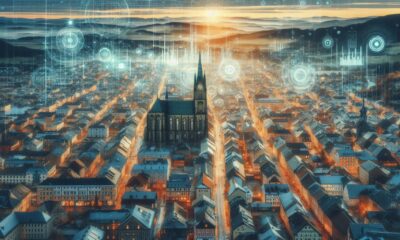
 Nyheter4 veckor sedan
Nyheter4 veckor sedanBrookfield ska bygga ett AI-datacenter på hela 750 MW i Strängnäs
-

 Nyheter3 veckor sedan
Nyheter3 veckor sedanSilverpriset släpar efter guldets utveckling, har mer uppsida
-

 Nyheter4 veckor sedan
Nyheter4 veckor sedanTradingfirman XTX Markets bygger datacenter i finska Kajana för 1 miljard euro
-

 Nyheter2 veckor sedan
Nyheter2 veckor sedanUppgången i oljepriset planade ut under helgen
-

 Nyheter2 veckor sedan
Nyheter2 veckor sedanLåga elpriser i sommar – men mellersta Sverige får en ökning
-

 Analys2 veckor sedan
Analys2 veckor sedanVery relaxed at USD 75/b. Risk barometer will likely fluctuate to higher levels with Brent into the 80ies or higher coming 2-3 weeks
-

 Nyheter1 vecka sedan
Nyheter1 vecka sedanMahvie Minerals växlar spår – satsar fullt ut på guld



